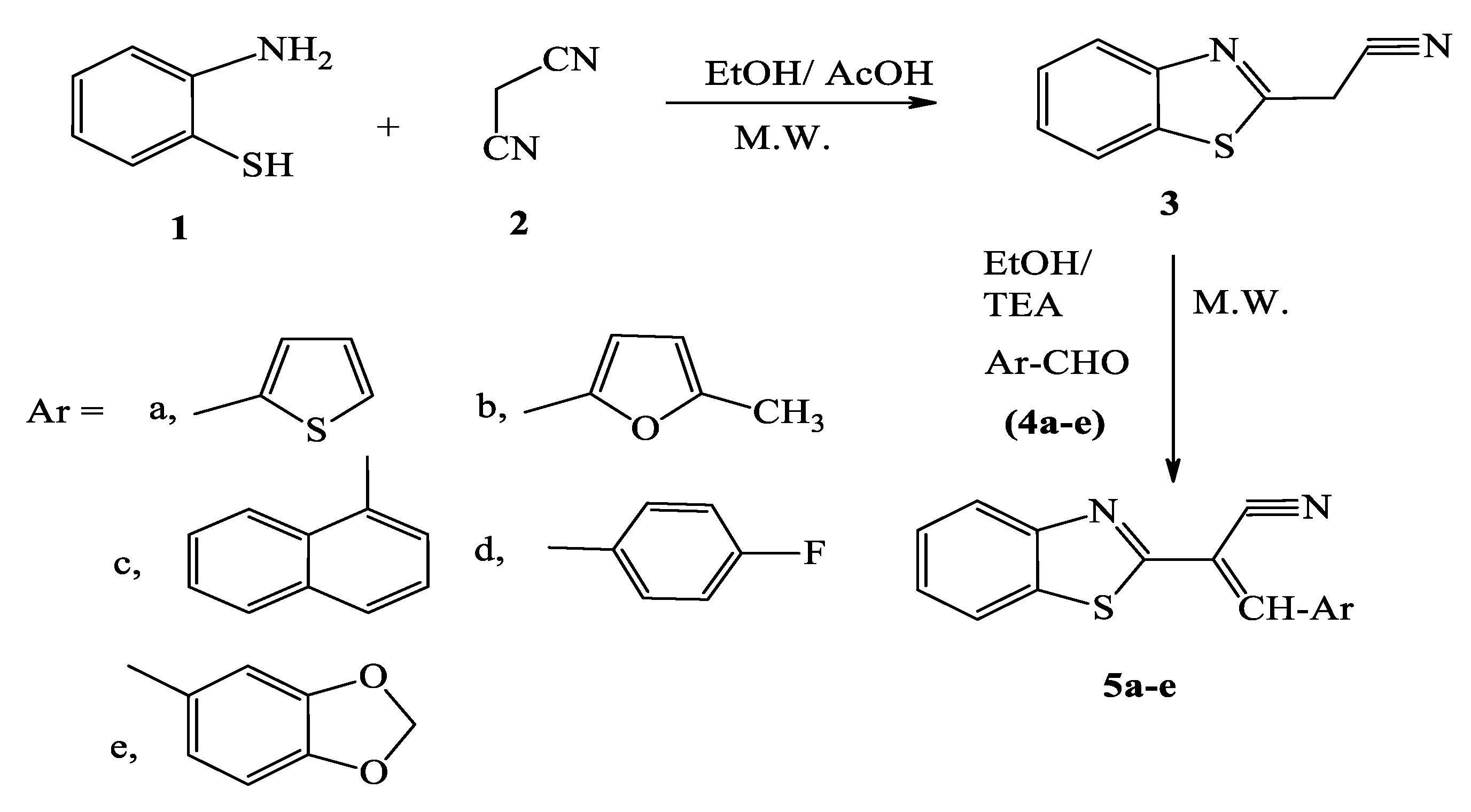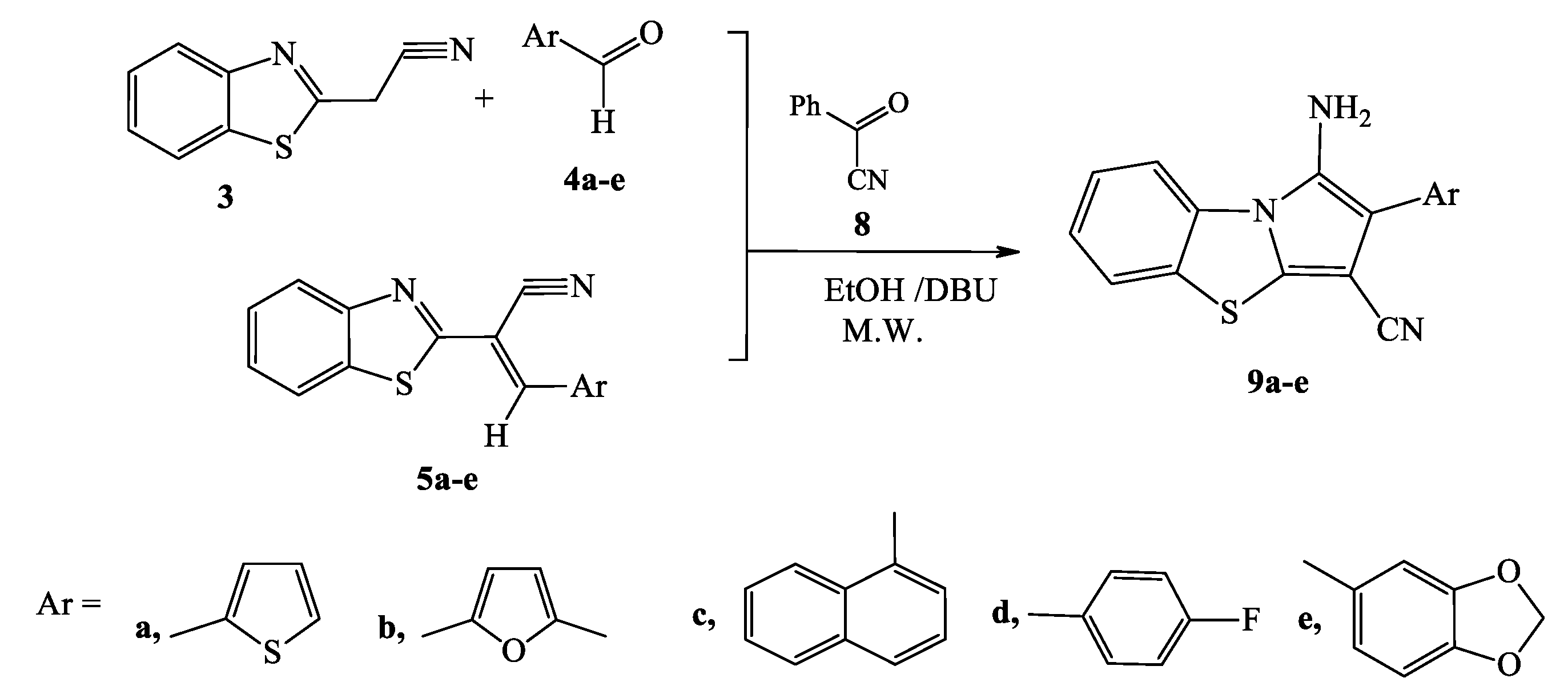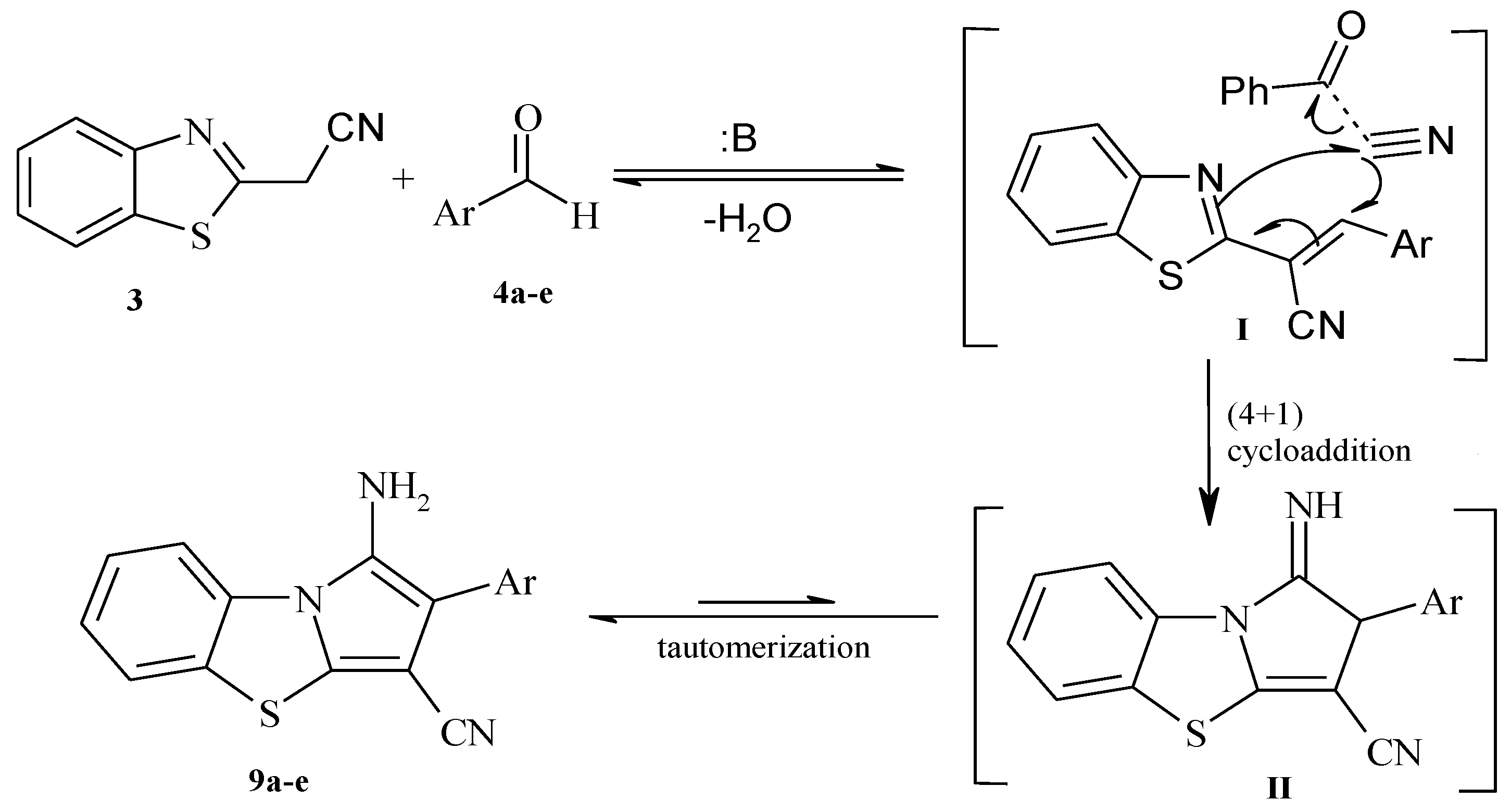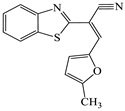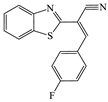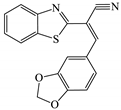3.2. Syntheses
General procedure. A mixture of compound 3 (0.87 g, 5 mmol), (5 mmol) of the appropriate aromatic aldehyde (thiophene-2-carboxaldehyde, 5-methylfuran-carbox- aldhyde, 1-naphthaldhyde, 4-fluorobenzaldhyde, and piperonal) 4a–e and TEA in ethanol was subjected to MWI at 60 °C for 4–8 min. The progress of the reaction was followed by TLC (petroleum ether (80–90): ethyl acetate, ratio:3:1). After cooling, solids were obtained, filtered, and recrystallized from a proper solvent to give 5a–e, respectively.
Green powder, crystallized from cyclohexane, mp. 153–155 °C; IR (KBr, cm
−1); 3108 (CH aryl), 2212 (CN), 1600 (C=N);
1H NMR (500 MHz, CDCl
3,
δ, ppm); 7.25(s, 1H, thiophene), 7.42 (t, 1H, Ar-
H), 7.52 (t, 1H, Ar-
H), 7.71 (d, 1H,
J = 4.92 Hz, thiophene), 7.82 (d, 1H,
J = 5.1 Hz, thiophene), 7.91 (d, 1H,
J = 8.01 Hz, Ar-
H), 8.05 (d, 1H,
J = 8.01 Hz, Ar-
H), 8.40 (s, 1H, =CH),; Its MS (m/z), 268 (M
+); C
14H
8N
2S
2 (268.3); Anal. Calcd.; % C: 62.66, % H: 3.00, % N: 10.44; found % C: 62.64, % H: 2.98, % N: 10.41. (
see Supporting Information).
Brown powder, crystallized from ethanol, mp. 150–151 °C; IR (KBr, cm−1); 2934, 2899 (CH aliphatic), 3054 (CH aryl), 2226 (CN), 1588 (C=N); 1H NMR (500 MHz, CDCl3, δ, ppm); 2.44 (s, 3H, CH3), 6.27(d, 1H, J = 5.6 Hz, furan), 7.19 (d, 1H, J = 5.68 Hz, furan), 7.44 (t, 1H, Ar-H), 7.48 (t, 1H, Ar-H), 7.84 (d, 1H, J = 8.10 Hz, Ar-H), 7.92 (s, 1H, =CH), 8.00 (d, 1H, J = 8.10 Hz, Ar-H); Its MS (m/z), 266 (M+); C15H10N2OS (266.3); Anal. Calcd.; % C: 67.65, % H: 3.78, % N: 10.52; found % C: 67.63, % H: 3.75, % N: 10.49.
Pale yellow powder, crystallized from dioxane, mp. 128–130 °C; IR (KBr, cm−1); 3050 (CH aryl), 2218 (CN), 1587 (C=N); 1H NMR (500 MHz, CDCl3, δ, ppm); 7.61 (t, 1H, Ar-H),7.80 (m, 4H, Ar-H), 8.02 (m, 2H, Ar-H), 8.11 (d, 1H, J = 8.76 Hz, Ar-H), 8.12 (m, 2H, Ar-H), 8.14 (d, 1H, J = 8.76 Hz, Ar-H), 9.08 (s, 1H, =CH); Its MS (m/z), 312 (M+, 80%); C20H12N2S (312.3); Anal. Calcd.; % C: 76.90, % H: 3.87, % N: 8.97; found % C: 76.88, % H: 3.85, % N: 8.94.
Yellow powder, crystallized from ethanol, mp. 161–163 °C; IR (KBr, cm−1); 3054 (CH aryl), 2226 (CN), 1588 (C=N); 1H NMR (500 MHz, CDCl3, δ, ppm); 7.20 (m, 2H, Ar-H), 7.42 (t, 1H, Ar-H), 7.50 (t, 1H, Ar-H), 7.90 (d, 1H, J = 8.10 Hz, Ar-H), 8.04 (m, 3H, Ar-H), 8.19 (s, 1H, =CH); Its MS (m/z), 280 (M+, 73%); C16H9FN2S (280.3); Anal. Calcd.; % C: 68.55, % H: 3.24, % N: 9.99; found % C: 68.54, % H: 3.22, % N: 9.97.
Yellow powder, crystallized from dioxane, mp. 222–224 °C; IR (KBr, cm−1); 2938, 2874 (CH aliphatic), 3054 (CH aryl), 2223 (CN), 1587 (C=N); 1H NMR (500 MHz, CDCl3, δ, ppm); 6.08 (s, 2H, O-CH2-O), 6.91 (d, 1H, J = 7.05 Hz, Ar-H), 7.41–7.45 (m, 2H, Ar-H), 7.50–7.51 (t, 1H, Ar-H), 7.73 (s, 1H, Ar-H), 7.89 (d, 1H, J = 6.9 Hz, Ar-H), 8.05 (d, 1H, J = 6.9 Hz, Ar-H), 8.13 (s, 1H, =CH); Its MS (m/z), 306 (M+, 66%); C17H10N2O2S (306.3); Anal. Calcd.; % C: 66.64, % H: 3.92, % N: 9.14; found % C: 66.62, % H: 3.90, % N: 9.13.
7-amino-6-(1,3-benzothiazol-2-yl)-5-(aryl)-2-thioxo-2,3dihydropyrido[2,3-d]pyrimidin-4(1H)-one (7a–e).
General procedure: (Method 1) under microwave irradiation.
(Method 1a): A mixture of compounds 5a–e (5 mmol) and 6-aminothiouracil 6 (0.7 g, 5 mmol) in DMF was placed in a microwave process vial. The vial was closed and subjected to microwave irradiation for 25 min at 150 °C/or in EtOH/TEA for 45 min at 100 °C. The progress of the reaction was followed by TLC. After cooling to room temperature, the solid formed was filtered off, washed with ethanol, dried, and crystallized from DMF.
(Method 1b): A mixture of 2-cyanomethyl-1,3-benzothiazol 3 (0.87 g, 5 mmol), 6-amino thiouracil 6 (0.7 g, 5 mmol), and appropriate aldehydes 4a–e (5 mmol) in DMF was placed in a microwave process vial. The vial was closed and subjected to microwave irradiation for 50 min at 150 °C. The progress of the reaction was followed by TLC. After cooling to room temperature, the solid formed was filtered off, washed with ethanol, dried, and crystallized from DMF.
(Method 2) using conventional heating.
(Method 2a): A mixture of compounds 5a–e (10 mmol) and 6-aminothiouracil 6 (1.43 g, 10 mmol) was heated under reflux in DMF/or EtOH/TEA for several hours. The reaction mixture was allowed to cool to room temperature and the solid formed was filtered off, dried, and crystallized from DMF.
(Method 2b): A mixture of 2-cyanomethyl-1,3-benzothiazol 3 (1.74 g, 10 mmol), 6-amino thiouracil 6 (1.43 g, 10 mmol), and appropriate aldehydes 4a–e (10 mmol) was heated under reflux in DMF for several hours. The reaction mixture was allowed to cool to room temperature and the solid formed was filtered off, dried, and crystallized from DMF.
7-amino-6-(1,3-benzothiazol-2-yl)-5-(thiophen-2-yl)-2-thioxo-2,3-dihydropyrido[2,3-d]pyrimidin-4(1H)-one (7a).
Brown powder, mp. > 300 °C; IR (KBr, cm−1); 3379, 3273 (NH2, NH), 3074 (CH aryl), 1680 (C=O), 1599 (C=N); 1H NMR (500 MHz, DMSO-d6, δ, ppm); 3.32–3.53 (brs, 1H, NH, D2O exchangeable), 7.19–7.21(m, 2H, Ar-H), 7.23 (m, 1H, Ar-H), 7.44 (brs, 1H, Ar-H), 7.45 (brs, 1H, Ar-H), 7.46 (brs, 1H, Ar-H), 7.59 (brs, 1H, Ar-H), 8.10 (d, 1H, J = 7.45 Hz, Ar-H), 12.31 (brs, 1H, NH), 13.00 (brs, 1H, NH) (NH2, 2NH,D2O exchangeable); 13C-NMR (125 MHz, DMSO-d6) δ ppm: 108.10, 114.00, 115.20, 118.00, 129.00, 130.00, 131.10, 131.50, 132.10, 135.80, 142.10, 149.20, 150.00, 156.80, 159.80, 160.00, 162.00 (C=O), 175.00 (C=S); Its MS (m/z), 409 (M+, 74%); C18H11N5OS3 (409.5); Anal. Calcd.; % C: 52.79, % H: 2.71, % N: 17.10; found % C: 52.76, % H: 2.70, % N: 17.08.
7-amino-6-(1,3-benzothiazol-2-yl)-5-(5-methylfuran-2-yl)-2-thioxo-2,3-dihydropyrido[2,3-d]pyrimidin-4(1H)-one (7b).
Pale red powder, mp. > 300 °C; IR (KBr, cm−1); 3400, 3381 (NH2, NH), 3045 (CH aryl), 2938 (CH aliphatic), 1675 (C=O), 1608 (C=N); 1H NMR (500 MHz, DMSO-d6, δ, ppm); 2.85 (s, 3H, CH3), 3.32 (brs, 2H, NH2 + H2O), 7.20 (d, 1H, J = 6.01 Hz, furan), 7.36–7.44 (m, 4H, Ar-H), 7.93 (d, 1H, J = 6.01 Hz, furan), 12.33, 13.07 (2brs, 2NH) (NH2, 2NH, D2O exchangeable); 13C-NMR (125 MHz, DMSO-d6) δ ppm: 19.50, 108.00, 114.10, 115.00, 118.80, 129.00, 130.00, 131.10, 131.40, 132.00, 135.80, 143.00, 149.20, 153.00, 156.80, 159.80, 162.00, 164.00 (C=O), 176.00 (C=S ); Its MS (m/z), 407 (M+, 70%); C19H13N5O2S2 (407.4); Anal. Calcd.; % C: 56.01, % H: 3.22, % N: 17.19; found % C: 56.00, % H: 3.19, % N: 17.17.
7-amino-6-(1,3-benzothiazol-2-yl)-5-(naphthalen-1-yl)-2-thioxo-2,3-dihydro pyrido[2,3-d]pyrimidin-4(1H)-one (7c).
Yellow powder, mp. > 300 °C; IR (KBr, cm−1); 3373, 3342 (NH2, NH), 3061 (CH aryl), 1678 (C=O), 1597 (C=N); 1H NMR (500 MHz, DMSO-d6, δ, ppm); 3.38 (brs, 2H, NH2), 7.29–7.93 (m, 11H, Ar-H), 11.88 (brs, 1H, NH), 12.76 (brs, 1H, NH) (NH2, 2NH, D2O exchangeable); 13C-NMR (125 MHz, DMSO-d6) δ ppm: 101.61, 110.42, 121.63, 122.90, 125.50, 126.04, 126.39, 126.65, 126.96, 127.46, 128.20, 129.00, 132.00, 133.90, 135.40, 135.90, 152.06, 153.41, 158.16, 160.10, 164.00 (C=O), 176.03 (C=S); Its MS (m/z), 453 (M+, 66%); C24H15N5OS2 (453.5); Anal. Calcd.; % C: 63.56, % H: 3.33, % N: 15.44; found % C: 63.53, % H: 3.31, % N: 15.40.
7-amino-6-(1,3-benzothiazol-2-yl)-5-(4-fluorophenyl)-2-thioxo-2,3-dihydropyrido[2,3-d] pyrimidin-4(1H)-one (7d).
Orange powder, mp. > 300 °C; IR (KBr, cm−1); 3380, 3368 (NH2, NH), 3059 (CH aryl), 1680 (C=O), 1600 (C=N); 1H NMR (500 MHz, DMSO-d6, δ, ppm); 3.05 (br, 2H, NH2), 6.82 (d, 2H, J = 7.9 Hz, Ar-H,), 7.10–7.99 (m, 4H, Ar-H), 8.11 (d, 2H, J = 8.1 Hz, Ar-H), 11.99, 12.69 (brs, 2H, 2NH) (NH2, 2NH, D2O exchangeable); 13C-NMR (125 MHz, DMSO-d6) δ ppm: 112.33, 115.51, 121.97, 122.67, 122.91, 123.16, 125.90, 126.70, 127.34, 131.88, 131.95, 133.41, 148.24, 152.20, 153.57, 153.74, 158.60, 159.71, 164.20 (C=O), 175.99 (C=S); Its MS (m/z), 421 (M+, 89%); C20H12FN5OS2 (421.4); Anal. Calcd.; % C: 56.99, % H: 2.87, % N: 16.62; found % C: 56.97, % H: 2.84, % N: 16.60.
7-amino-5-(piperon-2-yl)-6-(1,3-benzothiazol-2-yl)-2-thioxo-2,3-dihydropyrido[2,3-d]pyrimidin-4(1H)-one (7e).
Pale yellow powder, mp. > 300 °C; IR (KBr, cm−1); 3370, 3278 (NH2, NH), 3040 (CH aryl), 2924 (CH aliphatic), 1678 (C=O), 1608 (C=N); 1H NMR (500 MHz, DMSO-d6, δ, ppm); 6.08 (s, 2H, O-CH2-O), 6.90 (d, 1H, J = 6.9 Hz, Ar-H), 7.41–7.45 (m, 2H, Ar-H), 7.50–7.51 (m, 1H, Ar-H), 7.73 (s, 1H, Ar-H), 7.88 (d, 1H, J = 6.9 Hz, Ar-H), 8.05 (d, 1H, J = 7.01 Hz, Ar-H), 8.12, 9.63 and 9.73 (brs, 4H, NH2 and 2NH), (NH2, 2NH,D2O exchangeable); 13C-NMR (125 MHz, DMSO-d6) δ ppm: 102.10 (O-CH2-O), 108.00, 115.00, 118.20, 123.00, 128.00, 130.00, 132.10, 136.00, 142.00, 133.41, 153.00, 153.20, 156.40, 158.00, 162.00, 165.00, 166.00 (C=O), 175.99 (C=S); Its MS (m/z), 446 (M+, 71%); C21H13N5O3S2 (447.4); Anal. Calcd.; % C: 56.36, % H: 2.93, % N: 15.65; found % C: 56.33, % H: 2.92, % N: 15.64.
General procedure: (Method 1) under microwave irradiation.
(Method 1a): A mixture of 2-cyanomethyl-1,3-benzothiazol 3 (0.87 g, 5 mmol), benzoyl cyanide 8 (0.65 g, 5 mmol) and appropriate aldehyde 4a–e (5 mmol) in EtOH/DBU was placed in a microwave process vial. The vial was closed and subjected to microwave irradiation for 25 min at 120 °C. Cooling the mixture to room temperature the solid precipitate was collected by filtration, dried and crystallized from dioxane.
(Method 1b): A mixture of compounds 5a–e and benzoyl cyanide 8 in EtOH/DBU was placed in a microwave process vial. The vial was closed and subjected to microwave irradiation for (20–25) min at 120 °C. Cooling the mixture to room temperature, the solid precipitate was collected by filtration, dried and crystallized from dioxane.
(Method 2) using conventional heating.
(Method 2a): A mixture of 2-cyanomethyl-1,3-benzothiazol 3 (5 mmol), benzoyl cyanide 8 (5 mmol) and appropriate aldehyde 4a–e was heated under reflux in ethanol and trimethylamine for an appropriate time. The reaction mixture was allowed to cool to room temperature and the solid formed was filtered off, dried and crystallized from dioxane.
(Method 2b): A mixture of compounds 5a–e (5 mmol) and benzoyl cyanide 8 (5 mmol) was heated under reflux in ethanol and trimethylamine for an appropriate time. The reaction mixture was allowed to cool to room temperature and the solid formed was filtered off, dried and crystallized from dioxane.
Deep yellow powder, mp. 255–257 °C; IR (KBr, cm−1); 3420, 3412 (NH2), 3068 (CH aryl), 2249 (CN); 1H NMR (500 MHz, DMSO-d6, δ, ppm); 7.19 (s, 1H, Ar-H), 7.38–7.69 (m, 2H, Ar-H), 7.78–7.85 (m, 2H, Ar-H), 7.87 (m, 1H, Ar-H), 8.02 (m, 1H, Ar-H), 8.34 (brs, NH, D2O exchangeable); 13C-NMR (125 MHz, DMSO-d6) δ ppm: 102.20 (CN), 121.74, 123.43, 125.88, 127.00, 128.57, 133.35, 135.08, 135.53, 136.97, 138.83, 153.74, 162.38. Its MS (m/z), 295 (M+, 90%); C15H9N3S2 (295.3); Anal. Calcd.; % C: 60.99, % H: 3.07, % N: 14.23; found % C: 60.97, % H: 3.07, % N: 14.21.
Brown powder, mp. 232–234 °C; IR (KBr, cm−1); 3415, 3409 (NH2), 3090 (CH aryl), 2233 (CN); 1H NMR (500 MHz, DMSO-d6, δ, ppm); 2.85 (s, 3H, CH3), 7.20 (d, 1H, J = 5.9 Hz, furan), 7.22 -7.44 (m, 4H, Ar-H), 7.93 (d, 1H, J = 5.9 Hz, furan), 12.33 (d, NH, D2O exchangeable); 13C-NMR (125 MHz, DMSO-d6) δ ppm: 22.50 (CH3), 92.32 (CN), 100.00, 102.99, 115.84, 128.36, 130.03, 133.57, 136.77, 158.67, 159.08, 159.44, 161.71. Its MS (m/z), 293 (M+, 94%); C16H11N3OS (293.3); Anal. Calcd.; % C: 65.51, % H: 3.78, % N: 14.32; found % C: 65.50, % H: 3.76, % N: 14.29.
Pale red powder, mp. 260–262 °C; IR (KBr, cm−1); 3430, 3411 (NH2), 3100 (CH aryl), 2235(CN); 1H NMR (500 MHz, DMSO-d6, δ, ppm); 7.45–7.58 (m, 5H, Ar-H), 7.91 (m, 2H, Ar-H), 7.99 (m, 2H, Ar-H), 8.12 (m, 1H, Ar-H) 8.30 (m, 1H, Ar-H), 9.03 (brs, NH, D2O exchangeable); 13C-NMR (125 MHz, DMSO-d6) δ ppm: 109.00 (CN), 121.83, 123.26, 123.88, 125.61, 126.23, 126.84, 127.10, 127.66, 127.82, 129.22, 129.52, 132.55, 144.78, 153.75, 162.45. Its MS (m/z), 339 (M+, 81%); C21H13N3S (339.4); Anal. Calcd.; % C: 74.31, % H: 3.86, % N: 12.38; found % C: 74.30, % H: 3.84, % N: 12.36.
Yellow powder, mp. 269–270 °C; IR (KBr, cm−1); 3439, 3418 (NH2), 3098 (CH aryl), 2250(CN); 1H NMR (500 MHz, DMSO-d6, δ, ppm); 7.25 (d, 2H, Ar-H, J = 8.00), 7.40–7.62 (m, 2H, Ar-H), 7.85 (d, 2H, J = 7.98, Ar-H), 8.00 -8.15 (m, 2H, Ar-H), 9.49 (brs, 2H, NH2, D2O exchangeable); 13C-NMR (125 MHz, DMSO-d6) δ ppm: 90.54 (CN), 115.65, 121.83, 128.33, 130,16, 133.84, 135.74, 141.12, 141.58, 144.78, 154.77, 157.98, 158.09, 161.35. Its MS (m/z), 307 (M+, 88%); C17H10FN3S (307.3); Anal. Calcd.; % C: 66.43, % H: 3.28, % N: 13.67; found % C: 66.40, % H: 3.26, % N: 13.66.
White powder, mp. 248–250 °C; IR (KBr, cm−1); 3429, 3409 (NH2), 3080 (CH aryl), 2985, 2868 (CH aliphatic), 2253(CN); 1H NMR (500 MHz, DMSO-d6, δ, ppm); 6.08 (s, 2H, O-CH2-O), 7.41–7.51 (m, 3H, Ar-H), 7.73 (s, 1H, Ar-H), 7.88–7.89 (m, 1H, Ar-H), 8.04–8.12 (m, 2H, Ar-H), 9.42 (brs, 2H, NH2, D2O exchangeable); 13C-NMR (125 MHz, DMSO-d6) δ ppm: 92.32 (CN), 102.99, 115.84, 128.36, 130.03, 133.57, 136.77, 158.67, 159.08, 159.44, 161.71, 162.00, 162.89. Its MS (m/z), 333 (M+, 92%); C18H11N3O2S (333.3); Anal. Calcd.; % C: 64.85, % H: 3.33, % N: 12.60; found % C: 64.83, % H: 3.30, % N: 12.58.

